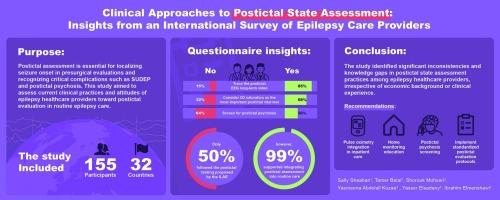临床方法后状态评估:从癫痫护理提供者的国际调查的见解。
IF 1.8
4区 医学
Q3 CLINICAL NEUROLOGY
引用次数: 0
摘要
目的:术后评估对于术前评估癫痫发作定位和识别严重并发症(如癫痫猝死)至关重要。本研究旨在评估目前的临床实践和癫痫护理提供者对临床常规设置后状态评估的态度。方法:于2023年5月至8月,使用谷歌Forms平台进行横断面在线调查。问卷包括五个部分,涉及参与者人口统计、术后临床和脑电图评估实践、关键监测工具以及将术后评估纳入常规护理的观点。根据世界银行的分类,参与者被分为高收入和低收入国家组。结果:共有来自32个国家的155名参与者完成了调查,其中79.4%是神经科医生。只有50%的人报告使用了国际抗癫痫联盟在2016年提出的标准化阳性检测。只有少数医疗服务提供者对产后精神病进行常规评估,高收入国家(24.5%)与低收入国家(41.2%;p = 0.04)相比显著减少。两组中约有三分之一的受访者没有监测氧饱和度。在获得长期视频脑电图的患者中,只有57.6%的人报告评估了后广义脑电图抑制和多态δ活动。尽管存在这些差距,但几乎所有答复者都支持将后诊评估纳入常规癫痫护理。结论:研究结果突出了各国在术后评估实践方面存在的显著差距,无论其收入水平或临床经验如何,并强调需要改进培训和标准化方案,以提高患者安全性和诊断准确性。本文章由计算机程序翻译,如有差异,请以英文原文为准。

Clinical approaches to postictal state assessment: Insights from an international survey of epilepsy care providers
Purpose
Postictal assessment is essential for seizure localization during presurgical evaluation and for identifying serious complications such as sudden unexpected death in epilepsy. This study aimed to evaluate the current clinical practices and attitudes of epilepsy care providers toward postictal state assessment in routine clinical settings.
Methods
A cross-sectional online survey was conducted using the Google Forms platform between May and August 2023. The questionnaire included five sections addressing participant demographics, postictal clinical and EEG assessment practices, key monitoring tools, and perspectives on incorporating postictal evaluation into routine care. Participants were stratified into higher-income and lower-income country groups based on World Bank classifications.
Results
A total of 155 participants from 32 countries completed the survey, of whom 79.4 % were neurologists. Only 50 % reported applying the standardized postictal test proposed by the International League Against Epilepsy in 2016. Postictal psychosis was routinely assessed by only a minority of providers, with significantly fewer in higher-income countries (24.5 %) compared to lower-income countries (41.2 %; p = 0.04). Approximately one-third of respondents in both groups did not monitor oxygen saturation postictally. Among those with access to long-term video EEG, only 57.6 % reported assessing both postictal generalized EEG suppression and polymorphic delta activity. Despite these gaps, nearly all respondents supported the integration of postictal assessment into routine epilepsy care.
Conclusions
The results highlight significant gaps in postictal assessment practices across countries regardless of income level or clinical experience and emphasize the need for improved training and standardized protocols to enhance patient safety and diagnostic accuracy.
求助全文
通过发布文献求助,成功后即可免费获取论文全文。
去求助
来源期刊

Journal of Clinical Neuroscience
医学-临床神经学
CiteScore
4.50
自引率
0.00%
发文量
402
审稿时长
40 days
期刊介绍:
This International journal, Journal of Clinical Neuroscience, publishes articles on clinical neurosurgery and neurology and the related neurosciences such as neuro-pathology, neuro-radiology, neuro-ophthalmology and neuro-physiology.
The journal has a broad International perspective, and emphasises the advances occurring in Asia, the Pacific Rim region, Europe and North America. The Journal acts as a focus for publication of major clinical and laboratory research, as well as publishing solicited manuscripts on specific subjects from experts, case reports and other information of interest to clinicians working in the clinical neurosciences.
 求助内容:
求助内容: 应助结果提醒方式:
应助结果提醒方式:


